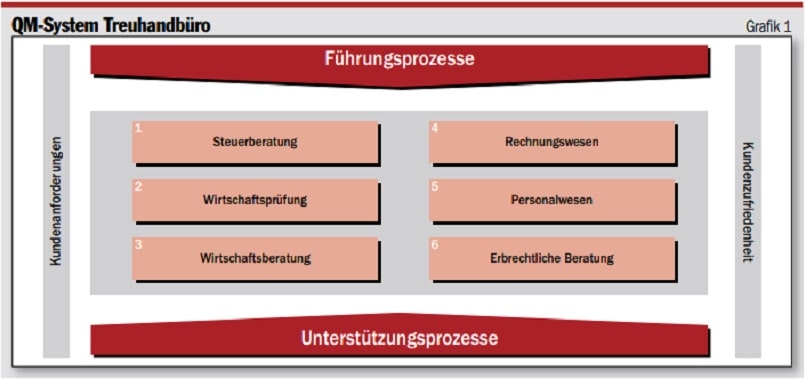QM system according to ISO 9001:2008
What benefits does a quality management system bring to a fiduciary company? How can process flows be standardised? Is it not rather the case that every client is unique? Budliger Treuhand AG in Zurich asked itself these and other questions during a two-year development process.

Dhe increased market and justification pressure increasingly confronts companies with the task of optimizing their resource requirements and legitimizing their work. Process-oriented quality management is becoming more and more important in today's development; behind this is the endeavor to constantly improve the company's internal procedures and processes. Efficiency and effectiveness of services, i.e. "quality", are to be proven. Quality or quality management is not an absolute term. Quality management is rather a collection of coordinated activities to ensure uniform and effective processes and structures.
Uniform understanding of quality
In order to design a suitable quality management system for Budliger Treuhand AG, those responsible translated and adapted the international "standards" into a tailor-made language and form. In June 2013, Budliger Treuhand AG was successfully certified according to ISO 9001:2008.
Through the intensive examination of the existing processes and structures, a uniform understanding of quality was established. Dealing with one's own expectations and ideas created a good basis for the implementation. In the course of setting up and developing the tailor-made system, a number of stumbling blocks had to be overcome: Order had to be created, existing processes were questioned, documents were sifted through, discussed, selected, discarded and redesigned. In addition, metrics had to be defined and system mastery had to be trained over a longer period of time.
"For us, the main focus was on standardizing all processes and documents as well as safeguarding the know-how of our employees. We invested a lot of time and had to be careful not to get lost in the details. A constant pragmatic approach as well as a constant focus on the company's benefit are indispensable to be able to successfully implement such an ISO certification." (Urs Karrer, Quality Officer, and Zafer Celik, Quality Manager)
The involvement of the management levels in the QMS led to a deeper understanding of the company-specific conditions. Through active involvement, a powerful system was created, behind which the entire management and the entire workforce stood. In retrospect, the QMS in accordance with ISO 9001:2008 has achieved many things: increased trust, greater transparency within the departments, a clear orientation framework and order, a clear understanding of the organization, networked objectives and process metrics, proof of compliance with legal requirements and, finally, a recognized, generally applicable and cross-industry quality management system.
The introduction of the QMS also changed the parameters for change and improvement and set in motion a continuous improvement process (CIP). System improvements are no longer expressed only in the sum of individual achievements, but through systematic action and coordination.









